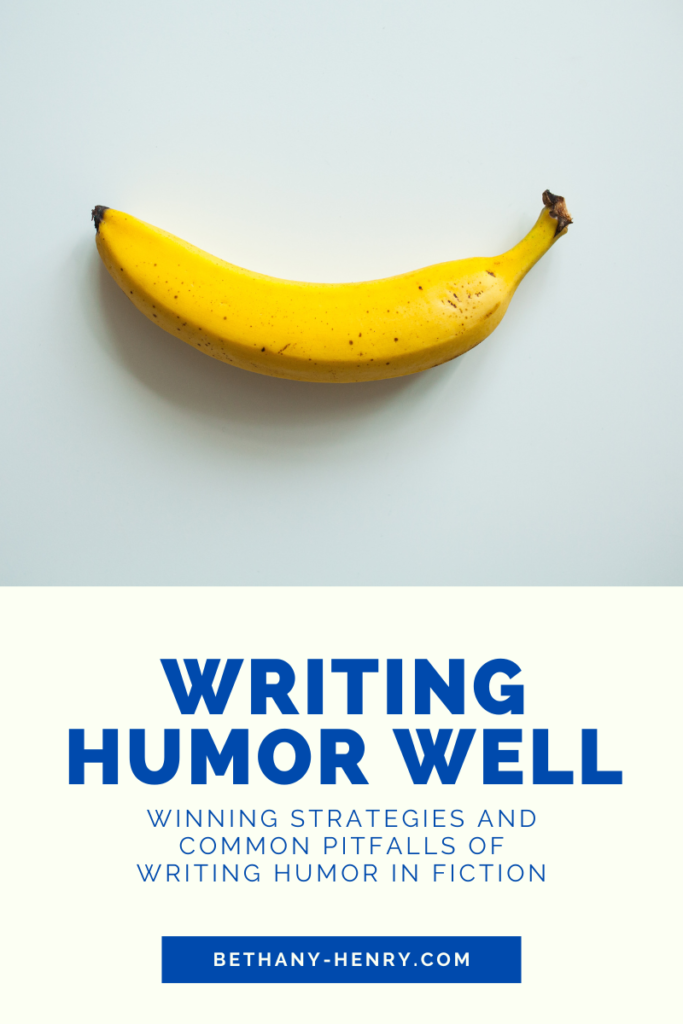
I hope you’ve had the giddy and almost magical experience of reading a book that makes you literally laugh out loud. Finding humor in our fiction is a wonderful thing!
However, often this is easier said than done. Telling ourselves to “write funny” doesn’t usually work and when a joke falls flat or the humor feels forced, well, that doesn’t do our writing any favors.
Today we’re going to look at different types of humor in writing, some common pitfalls, and 5 strategies for including humor in our own writing.
Writing Humor Well
Types of Humor
There are several different ways a story can be funny! Recognizing what types of humor fit into to our stories and personal writing style can help us lean towards our strengths.
Here are are a few different types of humor with examples- if you think of others feel free to comment below!
Absurdism
The comic absurd style is filled with random ridiculousness. Maybe you will go to smell a flower and find it is actually an alligator, maybe the sky is filled with flying meatballs, or perhaps the earth is flat and held up by four elephants while balancing on the back of a giant turtle.
Absurdism humor isn’t just for children, being open to surprise and joy can be a wonderfully magical quality to embrace for all of us.
Terry Pratchett is king of the comic absurd and I would recommend reading his Discworld series if you haven’t already had that pleasure. He uses his humor not only to entertain but also to poke fun and challenge our ideas of the world which brings us to our next style of humor…
Satire
Satire is when irony and exaggeration are used to criticize and expose stupidity or corruption, often in the context of politics. Basically it makes the target look ridiculous and uses humor as a way of discredit their position.
A famous example of this is Jonathan Swift’s A Modest Proposal in which he advocates cannibalism of the poor in order to mock the heartless attitudes of the rich in power.
Dry Humor
Dry humor is when funny things occur or are said with a lack of emotion. It relies on the reader to find the joke and part of the joke is, of course, the incongruous nature of the narrator’s deadpan delivery.
Lemony Snicket’s A Series of Unfortunate Events is a great example of dry humor.
Slapstick
This is often the most obvious and physical type of humor and it is the opposite of dry humor. This is where we would find fart jokes, practical jokes, and The Three Stooges falling off of ladders.
Janet Evanovich’s Stephanie Plum is a good example of madcap, slapstick comedy.
Wordplay
This involves twisting words around and using them in surprising and funny ways. Puns definitely fall into this category but there are lots of other ways to play with words as well!
A famous example of this is The Phantom Tollbooth by Norton Juster where the sidekick is a watch dog with a literal watch inside of him.
Common Pitfalls
We’ve all heard a joke fall flat. While everything we write may not hit the mark 100%, we certainly want to do our best to avoid turning off our readers. We want to amuse, not abuse, after all.
Here are several common pitfalls when trying to write humor.
Offensive Jokes
SERIOUSLY.
While sometimes we might get a laugh with an offensive joke, if it’s at someone else’s expense then it is hurting people and normalizing cruelty. Is that really what you want?
I believe that as writers and as human beings we have a responsibility to use our words and actions to treat others with respect and kindness. With our humor we may poke fun at others but we need to be responsible. Satire can be used to criticize those in power but shouldn’t be used to beat up on individuals who are already marginalized or vulnerable. Feedback can be helpful here to combat our own bias and blind spots because we all have them!
Inside Jokes
Okay, so it’s one thing to have a recurring gag that becomes an inside joke within your story. That be lots of fun for both you and your reader!
But sometimes the reader won’t understand the inside jokes that you and your best friends share. This is no longer fun and funny and probably can be cut from the story. Knowing your audience is key!
Trying Too Hard
This is like explaining a joke: at a certain point it’s just not funny anymore if we have to work too hard to shoehorn it into place. Maybe the joke fit into the first draft but then things changed. Forcing something to be funny doesn’t generally work. Sometimes the humor fits into the story and sometimes it just doesn’t hit the mark- it’s important to know when to cut the gag, move on, and let it go.
Disjointed Tone
We want our humor to fit the story and add to it, not detract or distract. If we add a pie to the face of our main character in the midst of a serious drama then that feels out of place. Knowing the style and tone of our story can help us recognize what types of humor to employ.
5 Strategies for Writing Humor
Like all things, writing humor well takes practice! Find what works for you and don’t be afraid to try a few things until you see what you like. And don’t forget to get feedback!
Here are a few strategies to get us started:
1. Identify our strengths, personal writing style, and type of story.
This will help you identify what types of humor may fit in naturally.
2. Use our characters.
This is a huge area of potential! Do we have strong personalities that can clash in amusing ways? A sarcastic sidekick who can provide biting and hilarious commentary? A bumbling friend who can add some slapstick humor? Our characters can be a rich area to provide humorous moments of many kinds.
3. Use our world.
Our worldbuilding can be anything we want and sometimes we forget that we can dream a little bigger! We can create environments that are predisposed to humorous outcomes or that provide the perfect backdrop for a funny situation.
4. Use our narration.
Our narration doesn’t need to be boring! In fact it really shouldn’t be. We can have fun with our words, and while we don’t need to pepper our pages with puns, we can certainly cultivate a style of writing that engages and amuses. This could be anything from a dry, sarcastic narrative style to a punny, ridiculous voice.
5. Fill it with the things we like.
What do we find funny? What makes us smile? Instead of being overly concerned with “being funny” or trying to please others, it’s important to embrace our own style. We can collect jokes and all the odds and ends that we enjoy in life and then turn around and fill our stories with shiny things we love.

Every page doesn’t need to make our readers laugh out loud but we should certainly be amusing, entertaining, and just plain fun to read. Happy writing!




